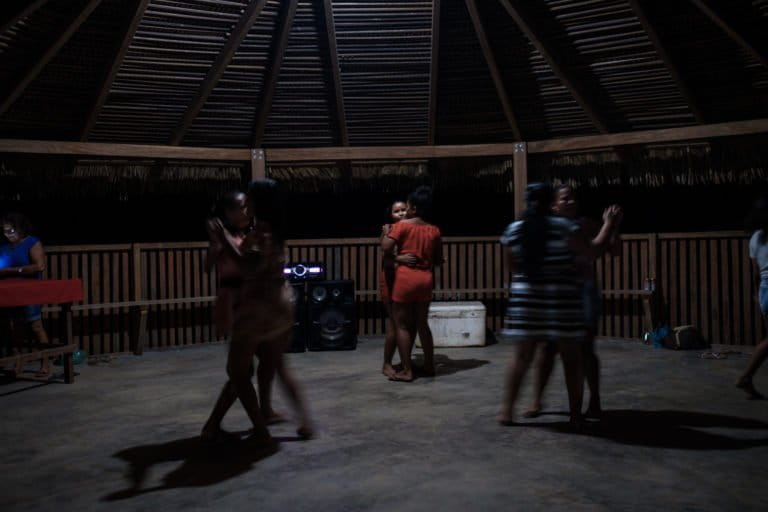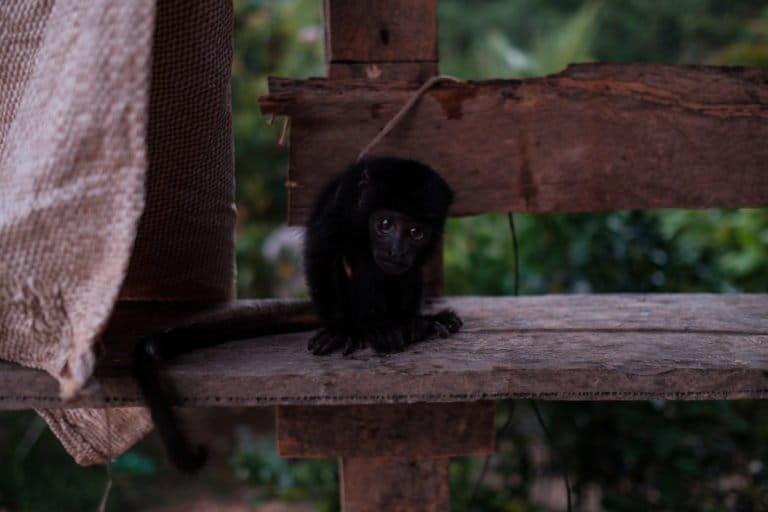- Canadian mining company Belo Sun wants to build a huge gold mine in the Big Bend of the Xingu River in the Brazilian Amazon, but faces opposition from Indigenous communities.
- In addition to the environmental impacts, experts warn of the risk of the proposed tailings dam rupturing, which could flood the area with 9 million cubic meters (2.4 billion gallons) of toxic waste.
- The same region is already suffering the impacts of the Belo Monte hydroelectric dam, which diverts up to 85% of the flow of the Xingu River, leading to a mass decline in fish that traditional riverside dwellers and Indigenous people rely on.
- The Belo Sun project was legally challenged last year, prompting supporters to harass and intimidate those who oppose the mine’s construction; tensions in the region remain high.
On a humid July afternoon, just as the sun was beginning to set over the Xingu River in the Brazilian Amazon, a young mother was preparing afternoon coffee when her phone rang. When she answered, a female voice claimed to have important information to share.
“Send an audio,” the mother replied, distracted by the boiling pots and the child playing on the concrete floor. “I can’t,” said the voice, sounding urgent through the weak connection. “I have to talk to you right now.”
The woman reported that hired gunmen were in the area looking for a community member who had just left town. He had been an outspoken opponent of a local mining project and had already received threats. The mother became worried: she had known the man since he was a child, and now he may never be able to return home to his family. In this remote and tight-knit community, these families fear constantly for each other’s safety. According to a study by Global Witness, Brazil was the most dangerous country in the world for environmental defenders this past decade.

Vila da Ressaca, a community of around 600 residents near the city of Altamira in the Amazonian state of Pará, is located in the middle of the so-called Big Bend of the Xingu, or Volta Grande in Portuguese. The river makes a peculiar S-turn here that’s significant and unique for both and ecological and anthropological reasons. The community’s few dozen mostly wooden shacks surrounded by forests, pasture and artisanal mines are ground zero in the saga of Canadian mining company Belo Sun and its plan to build the largest open-pit gold mine in Brazil on the banks of the river. Residents, experts and NGOs have been warning for years about the risks posed to an ecosystem that already suffers from the devastating effects of one of the largest hydroelectric dams in the world.
Inaugurated in 2016 in the face of intense opposition, the nearby Belo Monte dam diverts up to 85% of the flow of the Xingu to power its 18 turbines — a death sentence for the river, critics say. The region also continues to suffer from violence linked to land grabs, deforestation and illegal mining that have worsened since the completion of the dam.
“We’re starving, eating only bananas,” says Manuel, 71, a resident of Galo, a community downriver from the dam where hundreds of residents have already abandoned their homes. “We used to fish in the summer, now it’s just mud.”

Belo Sun’s Volta Grande project requires the hundreds of families who built Ressaca from nothing to make way for two huge craters, each 300 meters (nearly 1,000 feet) deep, along with a tailings dam about 13 stories high. The latter, according to experts, runs an “unacceptably high risk” of rupture that could flood the surrounding area with up to 9 million cubic meters (2.4 billion gallons) of toxic sludge within minutes. The cyanide to be used in the gold separation process could contaminate a precious ecosystem already on the brink of collapse.
But although the focus of the conflict is in Vila da Ressaca, it includes its neighbors, such as those in the Indigenous territories of the Yudjá/Juruna and Arara peoples, as well as half a dozen traditional and non-demarcated Indigenous communities downstream that have not yet been properly consulted. With Belo Sun’s licenses currently suspended, through various legal challenges, the fate of the project and those living in its shadow are stuck in a tense limbo.
Even so, “the communities have not given up fighting for their territory, they continue to file complaints with human rights bodies inside and outside the country,” says Ana Laíde Barbosa, a representative of the Xingu Vivo Para Sempre Movement, which supports marginalized communities fighting for their rights and those of the environment. “[Communities] are coordinating with each other through guardian nuclei and with other peoples like the Munduruku of the Tapajós, providing training on the consultation process and on their Projects for Life,” Laíde says, referring to cells of an activist network being formed in communities along with their sustainability projects being funded by local and foreign NGOs.

For nearly a decade, communities dealing with the aftermath of the Belo Monte project have suffered from its flawed consultation process, which, experts argue, repeatedly ignored the right of residents to prior, free and informed consent to such projects.
Starting in 2012, residents of Ressaca and neighboring communities complained that the company was restricting access to public areas, pressuring residents to sell their homes and encouraging the illegal purchase of plots, some of them on public land. The mining company hires a private security company, Invictus, whose employees conduct armed patrols while monitoring, questioning and intimidating citizens in public areas.
Frustrated by the lack of progress on the project, local supporters of the Belo Sun mine blame critics for impeding much-needed development in a region lacking jobs and investment in education, health care and infrastructure. However, the project will offer few opportunities for workers without the prerequisite technical skills and training that modern large-scale mining demands.
“We know how to work with our hands, but this enterprise will be totally mechanized and high-tech,” says Josué, 46, a longtime resident of Ressaca. “If you don’t have a degree and you have to move to the city, you’re finished.”

In the wake of legal challenges that suspended the company’s installation license last year, threats of violence against environmental and human rights defenders have increased in both intensity and severity. An elderly community leader in Ressaca who has been critical of Belo Sun was accosted in the street and threatened by a local supporter of the mining project. A second elderly man reported having his door kicked in and his home invaded by several men who threatened him to keep his criticism to himself. After receiving multiple threats, a third community leader was forced out of the community he has called home for decades and is currently being supported by the international human rights organization Frontline Defenders.
Others report that they are being monitored by strangers and are afraid to go anywhere alone. Several residents alleged that local vendors and river transport providers are charging exaggerated prices amid an economic downturn coupled with high inflation, in order, they say, to force Belo Sun’s critics out of the community. While the Vila da Ressaca has access to the city of Altamira via both the Xingu River and the Trans-Assurini road with its ferry connection, the river is the fastest and also the safest way to travel; accidents are common in this region where there’s practically no police presence. All those interviewed by Mongabay asked that their identities not be published due to the risk of reprisals.
“[Belo Sun’s supporters] don’t want us here,” reported one resident who has received threats because of their opposition. “They or someone in their family thinks they have something to benefit from this project, so they take it personally.”
The 2018 election of Jair Bolsonaro as president saw Belo Sun gain allies in the federal government. A controversial bill tabled by the Bolsonaro administration aims to open up Indigenous lands to the “unrestricted” extraction of natural resources, despite this being forbidden under Brazil’s Constitution. Together with Funai, the federal agency for Indigenous affairs, Belo Sun has pushed for private meetings with Indigenous communities — in defiance of national health protocols during the height of the COVID-19 pandemic, which claimed the lives of more than 1,000 Indigenous people in Brazil.
At the end of 2022, an investigation revealed that Belo Sun had closed a deal with Incra, the federal agency responsible for land reform, opening up 24 square kilometers (9 square miles) of land for the company’s use in exchange for trucks, laptop computers, GPS devices, and an undisclosed percentage of its mining revenue. Several families whose plots were part of the agreement reported that they weren’t even aware of the deal. Public defenders at the state and federal levels have challenged the legality of the deal, but there’s no ruling yet on the matter.

In early 2021, Bolsonaro signed a decree outlining his government’s Pro-Strategic Minerals Policy, which aims to accelerate environmental licensing for projects deemed “strategic,” such as Volta Grande. In April, the Federal Mining Agency (ANM) named an ex-director of Belo Sun to the position in the agency responsible for the Volta Grande region.
Bolsonaro and his deputy, former military general Hamilton Mourão, held separate personal meetings with Stan Bharti, founder of Toronto-based asset firm Forbes & Manhattan (F&M). Bharti previously served as a director at Belo Sun, while F&M is listed as a paid consultant in the miner’s reports to shareholders. Through a subsidiary, F&M operates another controversial mining project in the neighboring state of Amazonas, which stands accused of carrying out illegal exploration inside Indigenous territory without the community’s consent.

Bolsonaro’s four years in power have seen a political campaign to maximize resource extraction in Brazil’s mineral-rich Amazonian region. This has led to record levels of deforestation and violence linked to illegal land grabbing, with September 2022 marking the worst month of deforestation in more than a decade. The Bolsonaro administration has also been criticized for its broad denial of Indigenous land claims, many of which have been stuck in review for years.
“They say we’re not Indigenous,” says Iranilde Juruna, 58, who lives in an Indigenous community known as Mayaká, which sits inside a recent extension of the Paquiçamba Indigenous Territory. Iranilde says she was exiled from her village for standing against the Belo Sun project. “I’m the granddaughter of the matriarch [of Paquiçamba],” she says. “[The territory] wouldn’t exist without my father. We just want respect.”
She represents one of several villages along the Big Bend of the Xingu whose leaders say their existence is threatened by the Belo Sun proposal and who are being overlooked because their lands aren’t recognized by the federal government. At the time of writing, with Bolsonaro’s four-year term coming to an end, “not a single centimeter” of Indigenous land has been demarcated — just as he’d promised in his campaign years earlier.
Raphaela Xipaya, 33, says she’s frustrated that a Canadian company gets to decide who is worthy of consultation. “They beat their chests saying that the Indigenous people were consulted, but it’s not just the Juruna [of the Paquiçamba Indigenous Territory] here,” she says, pointing to other Indigenous peoples such as the Kuruaya who, like her own family, have lived on the banks of the Volta Grande for decades, unrecognized by the authorities. Raphaela also complains of the uncontrolled influx of non-Indigenous settlers into her family’s ancestral lands. “There’s no more land left. We’re struggling to preserve and maintain what we have left.”
Banner image: The Big Bend (Volta Grande) of the Xingu River, with Vila da Ressaca in the foreground, the site of the proposed Belo Sun gold mine in Pará state, in the heart of the Brazilian Amazon. Image by Andrew Johnson.
This story was reported by Mongabay’s Brazil team and first published here on our Brazil site on Jan. 12, 2023.
